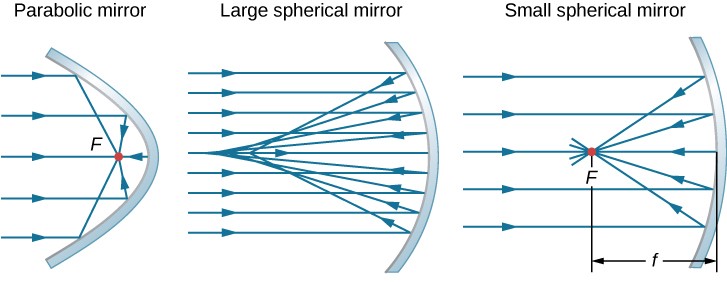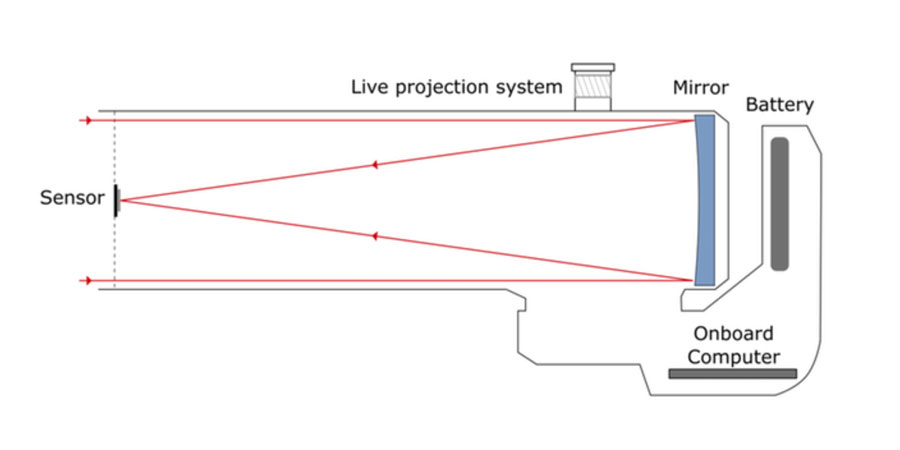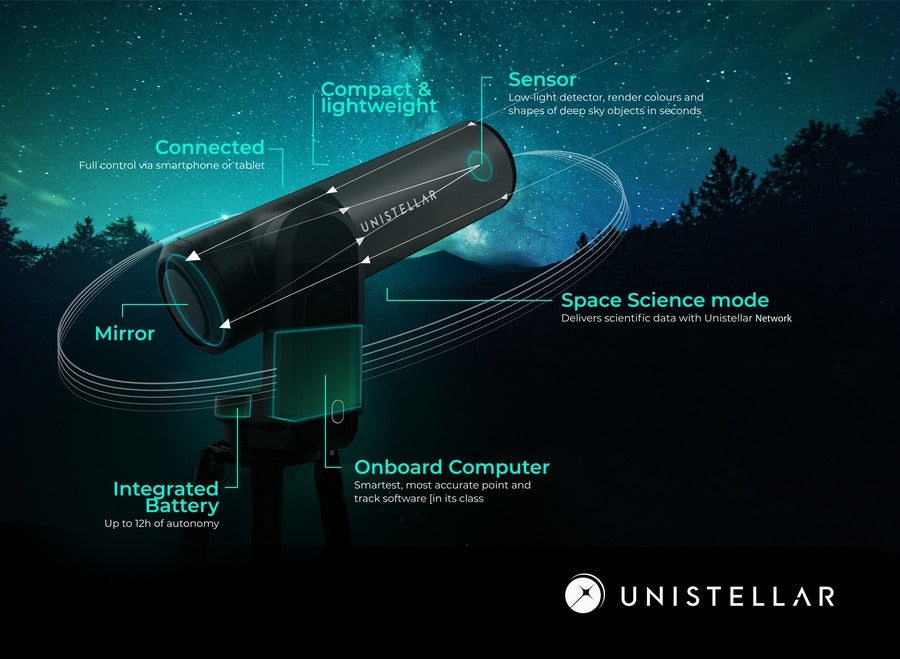Table of Contents
3. Light and Telescopes
1. Light
Light can be described both as a particle and a wave. Light is made of particles called photons and (at the same freaking time) waves called electromagnetic waves. Let us try to understand light as a wave first.
The best way to visualize a wave is to use the example of a water wave. In the following video, you see the largest replica of an ocean created inside a huge dome by US Navy. They use this indoor ocean the size of a football field for experimenting with the effect of waves on oceangoing ships.
If you see the first five minutes of the video, you will realize that waves are created by huge ‘oscillators’ on the sides of the pool. Compare this video with your experience of watching waves in a river, sea or just in a bucket of water. If you stir the water in a bucket with your finger, ripples are created on the surface of the water that travel in different directions. When a boat passes through the center of a river, you see waves coming toward you standing on the bank. If you have been to a sea beach, you have felt the power of such a wave, the amount of energy such a wave can carry.
To create a wave, you must have a medium and a mover that can create motion in the medium. In case of a river, water is the medium and a boat could be the mover. In case of the ocean, mover is the moon, and your finger is the mover in case of a bucket of water.
What are the medium and mover for producing light waves? Charged particles are the mover and the electromagnetic field is the medium. The most familiar charged particle is an electron (responsible for electricity). If electrons move with an accelerated motion in an electromagnetic field, waves are produced in the field and light is nothing but this ‘electromagnetic’ wave. Remember, the field itself is not light, only the wave in the field is light.
Lightning is an enlightening example (video shows the famous lightning in the film Back to the Future from the 1980s). During the terrifying summer monsoon of Bangladesh in Barsha, you see lightning and thunder regularly for almost two months. They are more spectacular at night. How are these light and sound produced? When rain-clouds heavy with water (called ‘Pushkara’ by Kalidasa) gather in the sky, some parts of a cloud could become ‘positively charged’ and some other parts ‘negatively charged’. These ‘positive’ and ‘negative’ poles are nothing mysterious, negative parts have more electrons (which are negative) than the positive parts, that is all. The diagram below shows such a configuration.
Normally electrons cannot jump through air in an empty space. But when the difference between the positive and negative parts becomes too large, electrons rush toward the positive parts breaking the barrier of air. During this ‘discharge’ of high-energy electrons, light (lightning) and sound (thunder) are produced. Light is produced because the electrons stir the electromagnetic field creating ripples. And sound is produced because the heat released by the electrons expand the surrounding air violently producing something like an explosion, this is why thunders sound like an explosion. Imagine a gas cylinder suddenly exploding because of extreme heat; a thunder is very similar.
So light is nothing but waves. A wave can be completely described by its amplitude and frequency. Imagine you are standing on a sea beach knee-deep in water. You will feel one wave after another hitting you. Some waves are higher than others and ‘amplitude’ is nothing but the height of the wave. On the other hand, sometimes one wave comes very soon after another, sometimes they come slowly. Frequency is a measure of how closely spaced the waves are. High frequency waves would come to you literally more frequently (ignoring the ‘wave speed’ for now).

The top of the wave is called ‘crest’, the bottom the ‘trough’ (ট্রফ) and the distance from one crest to another is called ‘wavelength’ which is related to the frequency. Wavelength is the inverse of frequency. A high frequency wave has shorter wavelength, a low frequency wave has longer wavelength.
You can see the relationship between wavelength and frequency in the above simulation. Change the frequency using the slider and see what happens to the wavelength. You can also vary the amplitude and time. Varying the time would make the wave travel horizontally right or left.
Light can also be thought of as made of particles called photons and the energy of these photons are directly related to the frequency (or wavelength) in the wave description. High-frequency light waves are made of high-energy photons, low-frequency light waves are made of low-energy photons.
2. Color
It turns out ‘color’ is nothing but the ‘wavelength’ or ‘frequency’, each color is a light of a specific wavelength. There is only wavelength corresponding to each frequency. The wavelengths corresponding to the different colors of visible light are shown below.

The wavelength here is given in nano-meters (nm). So the shades of violet have wavelengths between 380 nm and 450 nm. Shades of blue have wavelengths between 450 nm and 495 nm. The range for green is 495–570 nm, for yellow 570–590 nm, for orange 590–620 nm and, finally, the wavelengths for giving the shades of red vary from 620 nm to 750 nm. Notice that the ultraviolet (to the left of violet) and infrared (to the right of red) parts are blackish because we cannot see those colors. Ultraviolet radiation from the sun is harmful for us and our body radiates infrared light to get rid of our excess energy as heat.
Sunlight is originally white. Newton passed this white light through a prism and understood that the white color is actually made of the 7 colors of the rainbow as shown here. You can clearly see that the violet waves have shorter wavelength and higher frequency compared to red waves. The other colors have wavelength and frequency that vary between those of violet and red.
One way you can feel closer to the concept of color is via clothes. In the classroom students are wearing clothes of different colors. Let us say the teacher brings to the front seven students who are wearing clothes of seven different colors of the rainbow: violet, indigo (dark blue), blue, green, yellow, orange and red. You can see the clothes because light reflected from them is reaching your eyes. But why do they have different colors.
They have different colors because each of their clothes is reflecting the light of a different color or wavelength or frequency. Red garments have special ‘red’ pigments that absorb all colors of white sunlight except the red. They look red because they can reflect red light very efficiently. Violet clothes reflect violet light and so on.
Why are we studying colors in astronomy? Because astronomical objects (stars, planets, nebulas, galaxies) also emit light of different colors and we can learn a lot about them by analyzing their colors. Compare this with a movie. A movie is made using light. Light of different colors reflected from the clothes and bodies of the actors and from the surrounding are captured using a movie camera and ‘motion pictures’ are created from the captured light. When you see the reflected light on your screen you understand the characters; just from the images and colors you can understand the feelings and inner thoughts of the characters in a movie.
In astronomy, we can know the inner structure of stars and galaxies using their light of different colors detected by our telescope. And not just that, we can also know something about the chemical composition of stars and galaxies using colors.

This is the ‘spectrum’ of sunlight, meaning the light of the sun at different colors. Note that this spectrum is not the same as the spectrum you saw in the beginning of this section. The previous spectrum was smooth, that did not have any black lines and showed all the shades of all the seven colors. But some shades of some of the colors are missing in this spectrum. There are hundreds of such ‘missing colors’ and only a few prominent missing colors (called ‘absorption lines’) have been identified here using the letters A, B, C, D, E, F, G, H and K.
Why are some colors (light at some wavelengths or frequencies) missing? The sun emits smooth light, meaning it emits light at all colors from violet to red. But the sun has an atmosphere where there are many different chemical elements. The elements absorb light of specific colors. Each element can only absorb the light of one specific color. Each line correspond to the absorption of light at a specific color by a specific element. So the lines directly tell us which elements are present in the atmosphere of the sun.
A and B lines are created by oxygen molecules, C lines by hydrogen atoms, D by sodium, E by iron, and G, H and K by calcium. So the dark ‘absorption lines’ or the ‘missing colors’ give away the chemical composition of stars.
3. Telescopes
A telescope works almost the way our eyes work. Our eyes are made of lenses that can bend light to focus them around a single point as shown below.

The lens produced an inverted image of the leaf on the back of the eye in a plane called the retina. There are receptors in retina that convert the photons of light to chemical signals and then send them to the brain via the optic nerve as electrical signals. That means our vision has 3 components: the collector (lens), the sensor (retina) and the processor (brain). A modern telescope also has exactly these 3 components.
In case of modern telescopes, a mirror is used as the collector for focusing light. The sensor is made of an electronic device called the CCD that can convert photons to electrons. The electrons are then sent from the sensor to a computer that works as the processor. So the mirror is like the lens of our eyes, the CCD is like the retina and the computer is like the brain. Let us see how the collector (or reflector) works.

This is a typical ‘optical tube’ of a small amateur telescope of the Schmidt-Newtonian type. It has two mirrors: the bigger ‘primary’ mirror and the smaller ‘secondary’ mirror. Astronomical objects are so far away from us that their light enters our optical tubes always parallel to each other. Here you see two such lightrays (red dashed parallel lines) entering the tube from the left. They are reflected from the primary mirror and sent to the secondary mirror which in turn reflects them to the eyepiece. If you look through the eyepiece, you see an enlarged ‘image’ of the ‘real’ object out there in the sky.
Modern telescopes do not have eyepieces. Astronomers do not look through an eyepiece anymore. Instead, they take pictures of the sky using sensors, receivers or detectors which will discuss in the next section. This section is dedicated to the collector.
The initial collectors or reflecting mirrors were spherical, but large spherical mirrors cannot focus light properly and we do need large mirrors to collect as much light as possible. To solve this problem, parabolic mirrors were invented.

Small spherical mirrors can focus all parallel rays onto a single point $F$ at a distance $f$ from the mirror. But in case of large spherical mirrors, different rays meet at different points. If we cannot focus all the rays onto a single point, we cannot detect properly using a sensor which cannot be at multiple places at the same time. If all light are focused at a single point, a sensor located there would be able to receive all of them. This is why parabolic mirrors were made in the 17th and 18th centuries. They are more curved then a spherical mirror (left panel) and their shape is not described by a circle but a parabola. All modern telescopes use parabolic reflectors.
Here is a comparison of the largest current and planned visible-light telescopes. Extremely large mirrors are now made using multiple smaller pieces. For example, the mirror of the recently-sent James Webb Space Telescope (lower left) is made of 18 hexagonal segments.
4. eVscope and eQuinox
In this course, you will use an eQuinox telescope made by Unistellar for your final project. Unistellar makes two models: eVscope and eQuinox. The eVscope has a live projection system in place of an eyepiece so that people can have a sneak-peek of what the telescope is observing. The eQuinox does not have any eyepiece or live projection system. Both models work in a similar way. The telescope creates a WiFi network that you connect to using your phone. Then you can open the ‘Unistellar’ app on your phone and control and move the telescope using the app. The field of view of the telescope is always visible on the app and you can capture an image whenever you want.

The telescope has the same 3 parts mentioned above: collector, sensor, processor. The collector, however, is made of a single mirror. There is no secondary mirror at the focal point of this mirror, but the sensor is placed there instead. The sensor converts all light reflected by the mirror into electrons. The electrons are sent to the ‘onboard computer’ (the processor) located at beside the optical tube. This is a diagram of eVscope.

The parts are more clearly identified in this diagram of an eQuinox. The integrated battery located at the bottom of the tube can give backup for almost 10 hours, that is one night of observing time.
This telescope does not enlarge the image but rather, like all modern telescopes, take high-resolution pictures of various objects of the sky. If it has high resolution, you can always zoom in using a computer and see more details of the object. The ‘zooming in’ is almost like the modern equivalent of the optical ‘magnification’ used in the olden days.
The ‘field of view’ (FoV) of the telescope is around 0.5 degrees, that is the size of an image taken by eVscope or eQuinox is around 0.5 degrees, almost same as the size of the sun or the moon as viewed from earth. You can hide the moon completely using your pinkie, that means 0.5 degrees (30 arcminutes) is the size of your pinkie, the little finger.
5. Seeing the invisible
There are light waves beyond ultraviolet at the high-frequency end and beyond infrared at the low-frequency end. Heinrich Hertz detected such a wave for the first time and named it ‘x-ray’ as it was unknown then. Later many more ‘invisible’ light waves have been found. We use microwave light for heating our food and watching TV and we use radio waves for all kinds of wireless communication and the all-important Global Positioning System (GPS).

X-rays and gamma-rays are shorter (higher frequency) than visible light and radio and microwaves are longer (lower frequency) than visible light as shown above. There are telescopes custom-made for detecting light at all these wavelengths or frequencies. The ultraviolet and infrared wave are not shown here, but we have telescopes for detecting those light as well.

This figure shows the opacity (opposite of transparency) of Earth’s atmosphere at different wavelengths ranging from radio waves all the way to gamma rays. Earth’s atmosphere is 100% opaque to x-rays and gamma-rays, so we have to send telescopes to space for observing those waves coming from astronomical objects. Visible light and the near-infrared part can be seen from the surface, but the far-infrared part of the spectrum can be observed only from space. The atmosphere is almost completely transparent to radio waves. So radio astronomers are pretty happy on earth.
And radio astronomy is having a huge boost similar to some other branches of astronomy. Around the year 2030, the largest scientific facility in the world will be a radio telescope so large that it spans two continents: Africa and Oceania. The telescope, named the Square Kilometer Array (SKA), will be an array thousands of antennas scattered throughout the globe. The higher frequency antennas will be in Southern Africa and the lower frequency parts will be in Australia and New Zealand. But many countries are working together to make this dream come true as you see in the promotional video below.
I did my postdoctoral research with the SKA and continue to collaborate with the SKA community from IUB.


